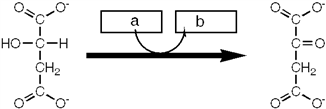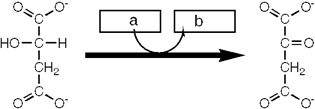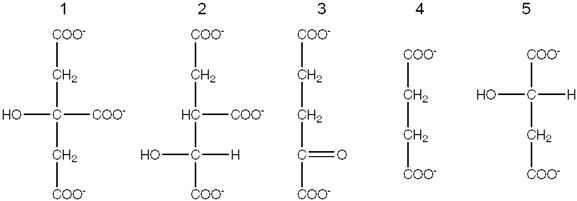A) I
B) II
C) III
D) IV
Correct Answer

verified
Correct Answer
verified
Multiple Choice
Fluorine is related to the citric acid cycle because:
A) fluoroacetyl-CoA is also a substrate for citrate synthase
B) fluoroacetate, found in poisonous plants, acts as an inhibitor of aconitase
C) fluorocitrate acts as a potent inhibitor of the citric acid cycle
D) all of these
Correct Answer

verified
Correct Answer
verified
Multiple Choice
The reaction of the citric acid cycle that does not take place in the mitochondrial matrix is the one catalyzed by:
A) fumarase
B) citrate synthase
C) isocitrate dehydrogenase
D) succinate dehydrogenase
E) All of these reactions take place in the matrix
Correct Answer

verified
Correct Answer
verified
Multiple Choice
The citric acid cycle is also known as the _____.
A) Calvin cycle
B) Krebs cycle
C) Embden-Meyerhof cycle
D) Kolb's cycle
Correct Answer

verified
Correct Answer
verified
True/False
The enzyme "aconitase" is also known as "condensing enzyme"
Correct Answer

verified
Correct Answer
verified
Multiple Choice
Which of the following cannot cross the inner mitochondrial membrane?
A) malate
B) phosphoenolpyruvate
C) succinyl-CoA
D) oxaloacetate
Correct Answer

verified
Correct Answer
verified
Multiple Choice
Which enzyme catalyzes the reaction shown? 
A) isocitrate dehydrogenase
B) malate dehydrogenase
C) fumarase
D) succinate dehydrogenase
E) none of these
Correct Answer

verified
Correct Answer
verified
Multiple Choice
Most of the products of the catabolism of sugars, fats and amino acids enter the citric acid cycle as:
A) pyruvate
B) acetyl-CoA
C) malate
D) all of these
E) none of these
Correct Answer

verified
Correct Answer
verified
Multiple Choice
Which enzyme catalyzes the reaction shown? 
A) isocitrate dehydrogenase
B) pyruvate dehydrogenase
C) fumarase
D) succinate dehydrogenase
E) none of these
Correct Answer

verified
Correct Answer
verified
Multiple Choice
Which of the following statements concerning the glyoxylate pathway is false ?
A) It utilizes one mole of acetyl-CoA per cycle.
B) It can produce a net synthesis of 4-carbon fragments that are intermediates of the citric acid cycle.
C) It usually occurs in the mitochondria
D) It is the main pathway that allows for synthesis of sugars from acetyl-CoA.
Correct Answer

verified
Correct Answer
verified
True/False
The "energy charge" in a cell is important in the control of metabolism.
Correct Answer

verified
Correct Answer
verified
Multiple Choice
Which of the following is not a component of the pyruvate dehydrogenase complex?
A) pyruvate dehydrogenase
B) dihydrolipoyl transacetylase
C) dihydrolipoyl dehydrogenase
D) pyruvate dehydrogenase kinase
E) aconitase
Correct Answer

verified
Correct Answer
verified
Multiple Choice
The conversion of malate to oxaloacetate has a high + Δ G (it is endergonic) . It can take place because:
A) It is coupled to hydrolysis of the GTP produce earlier in the cycle.
B) It is coupled to hydrolysis of ATP from other sources.
C) It involves a substrate level phosphorylation.
D) The oxaloacetate product is used up in the subsequent reaction.
E) It is coupled to a strong reduction reaction.
Correct Answer

verified
Correct Answer
verified
Multiple Choice
Which of the following statements concerning the citric acid cycle as the central metabolic pathway is true ?
A) It is involved in the metabolism of sugars and amino acids.
B) It is involved in the metabolism of amino acids and lipids.
C) It links anaerobic metabolism to aerobic metabolism.
D) Many of its intermediates are starting points for synthesis of a variety of compounds.
E) All of these are reasons why the citric acid cycle is considered to be the central pathway.
Correct Answer

verified
Correct Answer
verified
Multiple Choice
Which group of small molecules best fit the boxes associated with the reaction shown? 

A) I
B) II
C) III
D) IV
Correct Answer

verified
Correct Answer
verified
Multiple Choice
Exhibit 19A The following compounds are all intermediates in the citric acid cycle.  Refer to Exhibit 19A. Which intermediate is formed from acetyl-CoA and oxaloacetate.
Refer to Exhibit 19A. Which intermediate is formed from acetyl-CoA and oxaloacetate.
A) 1
B) 2
C) 3
D) 4
E) 5
Correct Answer

verified
Correct Answer
verified
Multiple Choice
Isocitrate has _____ possible isomers, out of which only one is produced in the isomerization of citrate to isocitrate.
A) three
B) two
C) four
D) six
Correct Answer

verified
Correct Answer
verified
True/False
One round of the citric acid cycle generates about ten equivalents of ATP.
Correct Answer

verified
Correct Answer
verified
Multiple Choice
Which of the following reactions involves substrate-level phosphorylation?
A) isocitrate → α -ketoglutarate
B) citrate → isocitrate
C) succinate → fumarate
D) succinyl-CoA → succinate
E) acetyl-CoA + oxaloacetate → citrate
Correct Answer

verified
Correct Answer
verified
True/False
Weight loss in humans can be difficult to achieve, since we lack the ability to convert our fats to sugars, and it is difficult to change our metabolism to using fats as a primary energy source.
Correct Answer

verified
Correct Answer
verified
Showing 21 - 40 of 85
Related Exams